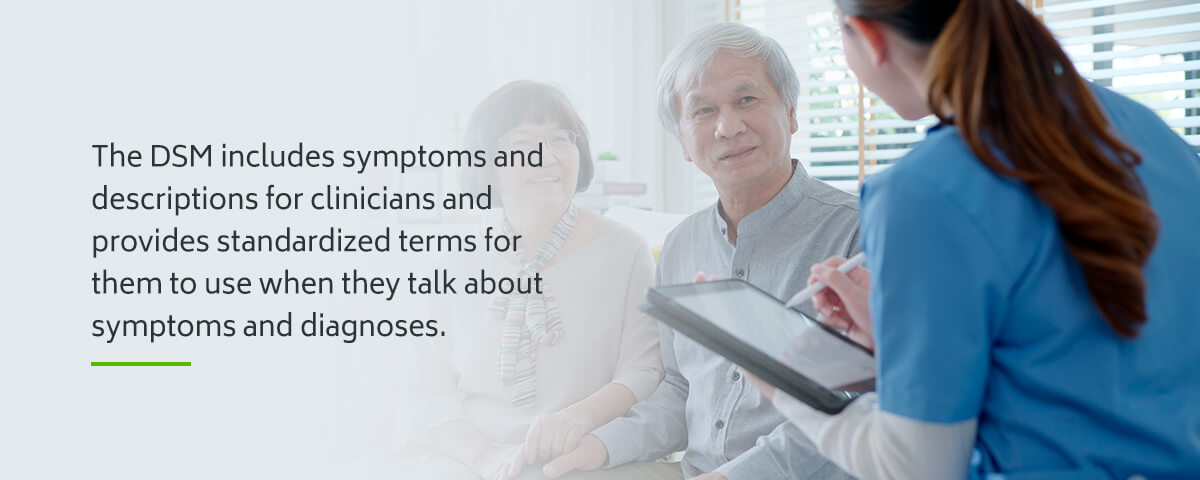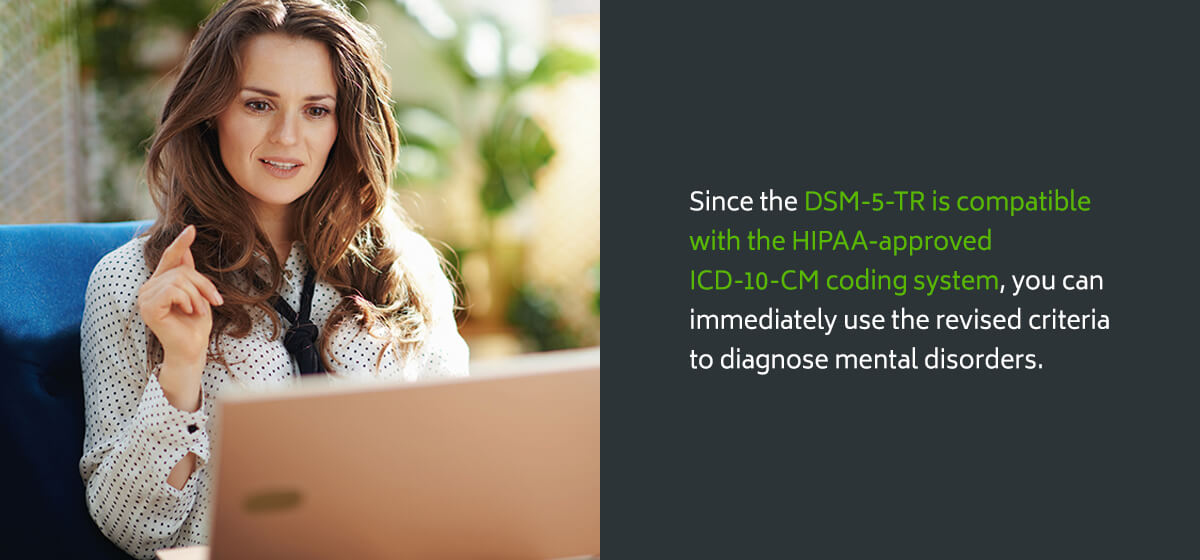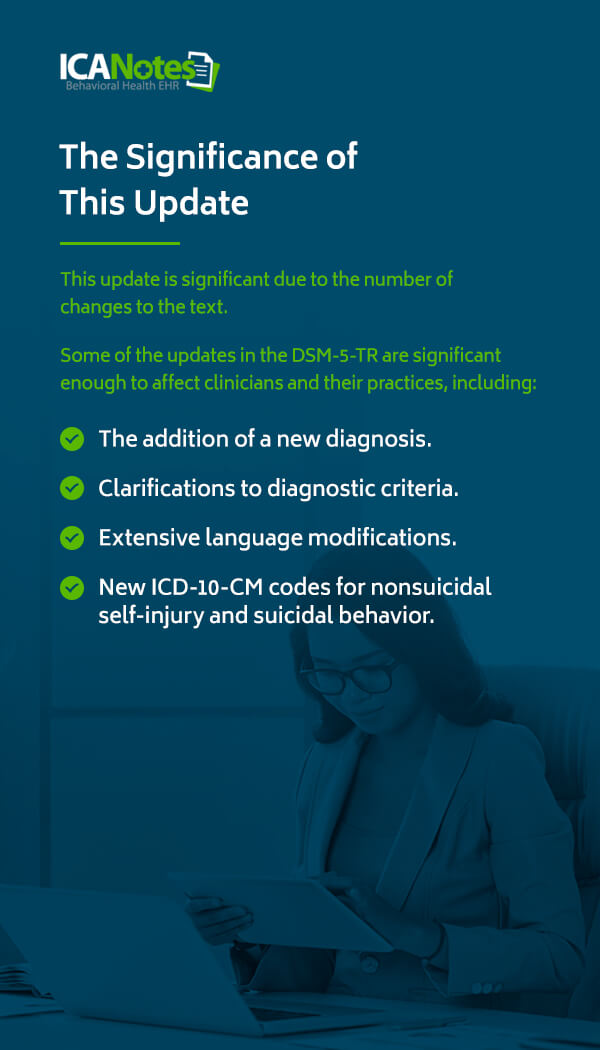
Recent DSM-5-TR Updates
As a behavioral health professional, it’s essential to stay up-to-date on changes to the DSM-5 to diagnose patients accurately and help them understand themselves. With the recent update from the DSM-5 to the DSM-5-TR, clinicians may be wondering how the changes will affect their practice.
This guide will help you understand the DSM-5-TR, the updates it includes, the significance of these changes, and how they will impact you.
Instant Webinar
The Changes, Challenges, and Triumphs Related to DSM-5-TR
Join us for this informative webinar where we will review the updated ICD-10 codes, updated diagnostic criteria, prognostic factors, and differential diagnoses through the text.
What Is the DSM-5-TR?
The Diagnostic and Statistical Manual of Mental Disorders (DSM) is a publication of the American Psychiatric Association (APA) that serves as a guide for healthcare professionals diagnosing mental disorders. The DSM includes symptoms and descriptions for clinicians and provides standardized terms for them to use when they talk about symptoms and diagnoses. Establishing a common language is essential for achieving the reliable, consistent diagnoses necessary for researching mental disorders and developing interventions.
The DSM Fifth Edition, Text Revision (DSM-5-TR) is the sixth edition of the DSM. The APA releases a new edition when there have been enough advances in the field to create, remove or substantially revise multiple disorders or diagnostic criteria sets. When new evidence or a need for greater clarity requires changes to the descriptions and criteria of mental disorders, the APA releases a text revision instead. While these changes are smaller in scope, the updates are still significant.
Although clinicians use the DSM-5-TR to assess and diagnose mental disorders, it does not include treatment guidelines or information. Of course, you need an accurate diagnosis before you can appropriately treat a mental disorder, which is what makes the DSM-5-TR so useful. As a clinician, you can also use the DSM-5-TR to measure the effectiveness of a treatment, as assessments can help you analyze changes in a patient’s severity levels in response to the treatment.
When Did the DSM-5-TR Update Happen?
The APA finalized the DSM-5-TR changes in 2022 after beginning their development in 2019. The process involved more than 200 experts, many of whom helped create the DSM-5. These individuals are experts in:
- Biology
- Statistics
- Genetics
- Nosology
- Epidemiology
- Public health
- Neuroscience
- Social and behavioral sciences
Who Made the Changes?
Experts participated on a strictly voluntary basis. They represented multiple mental health and medical disciplines, including psychology, psychiatry and social work. These experts conducted literature reviews that covered the years since the DSM-5’s publication and reviewed the text to identify any out-of-date material.
Four review groups reviewed every chapter — “Suicide,” “Culture,” “Forensic” and “Sex and Gender.” Each group focused on material that involved their area of expertise. The Ethnoracial Equity and Inclusion Work Group also reviewed the text before changes were made. The DSM Steering Committee and the APA Assembly and Board of Trustees reviewed and approved clarifications to diagnostic criteria. After the necessary updates were complete, the APA released the revision to the fifth edition.
Any individual can initiate the process of proposing changes to the DSM. A proposal needs to provide all the information that supports the suggested update.
When Was the Last DSM-5-TR Update Before This?
Other than a few occasional corrections, the APA has not updated the DSM-5 since its publication in 2013. The DSM-5’s development was initiated in 2000. During this time, work groups created a research agenda for the manual’s fifth major edition. These work groups generated hundreds of white papers, journal articles and monographs that provided a summary of the science relevant to mental health diagnosis. These items also identified gaps in the current research to direct what areas of research should receive the most emphasis.
The APA formed the DSM-5 Task Force in 2007 when they were ready to begin the revision. They also formed 13 work groups to focus on multiple areas. Since its initial publication, researchers and clinicians have uncovered inconsistencies and found a need for greater clarity that led to new editions. Four other versions of the DSM were published prior to the DSM-5:
- The first edition of the DSM was published in 1952.
- The second edition was published in 1968.
- The third edition was published in 1980.
- The fourth edition was published in 1994.
Changes in the Update
The Ethnoracial Equity and Inclusion Work Group reviewed and revised the text to ensure it gives appropriate attention to risk factors like experiencing discrimination or racism. They also made revisions to replace outdated terms with non-stigmatizing language. Other DSM-5-TR updates include:
- New references.
- ICD-10-CM code for suicidal behavior.
- ICD-10-CM code for nonsuicidal self-injury.
- A new disorder known as prolonged grief disorder.
- More than 70 modified criteria sets with clarifications.
- Extensive updates to the “Prevalence, Risk and Prognostic Factors” section.
- Extensive updates to the “Culture-Related Diagnostic Issues” section.
- Extensive updates to the “Sex- and Gender-Related Diagnostic Issues” section.
- Extensive updates to the “Association with Suicidal Thoughts or Behavior” section.
- Extensive updates to the “Comorbidity” section.
- Updates to the “Introduction” and “Use of the Manual” sections that provide context for terminology.
- Updates to ICM-10-CM codes, including more than 50 coding updates for conditions like substance intoxication and withdrawal.
- Reinstatement of the diagnosis of unspecified mood disorder to provide clinicians more time to observe a patient’s symptoms and give a more accurate diagnosis.
- Revised text for numerous disorders with updated sections on prevalence, features, culture, differential diagnosis, diagnostic markers and risk and prognostic factors.
Updated Diagnostic Criteria
Changes to the diagnostic criteria sets went through formal mechanisms beyond the text revision process for the DSM-5-TR. The DSM Steering Committee must conduct a formal proposal and review process for any changes to the criteria sets. The APA Board of Trustees and APA Assembly review and approve every proposed change to criteria sets.
The review process for some criteria sets, such as the new prolonged grief disorder, started before development began for the DSM-5-TR. Formal approval of changes to the criteria sets coincided with the DSM-5-TR’s publication. The updated diagnostic criteria can help mental health professionals better work with patients and file accurate claims with insurance companies.
Racial Constructs in Diagnosis
During the DSM-5-TR’s review process, the APA also took steps to address the effect of racism, discrimination and culture on psychiatric diagnoses.
International and U.S.-based experts in cultural psychiatry, anthropology and psychology formed the Cross-Cutting Review Committee on Cultural Issues. These members reviewed the texts to identify cultural influences on the characteristics of different mental disorders. Their review led to the incorporation of relevant information in the sections covering diagnostic issues related to culture.
The Ethnoracial Equity and Inclusion Work Group included mental health clinicians from diverse racialized and ethnic backgrounds. Each member has expertise in disparity-reduction practices and reviewed references to ethnicity and race to avoid perpetuating stereotypes and eliminate the inclusion of discriminatory clinical information.
Sex and Gender Constructs in Diagnosis
The DSM-5-TR updates include culturally sensitive language to describe sexual orientation, gender identity and gender dysphoria. Additionally, the “Gender Dysphoria” chapter now contains updates based on recent literature. Some of the changes to the terminology include the following:
- “Natal male” and “natal female” are now “individual assigned male at birth” and “individual assigned female at birth.”
- “Cross-sex medical procedure” is now “gender-affirming medical procedure.”
- “Desired gender” is now “experienced gender.”
ICD-10-CM Insurance Codes
The DSM-5-TR exclusively uses the International Classification of Diseases, 10th Revision, Clinical Modification (ICD-10-CM) codes, the version of the ICD currently in effect in the U.S. These codes are the only permissible diagnostic codes that clinicians in the U.S. can use for mental disorders. These codes are vital for medical record keeping, data retrieval, and collecting and compiling statistical information.
The updates to the DSM-5-TR should not impact insurance coverage or require you to change a diagnosis that you have already made. However, you can use the new ICD-10-CM billable code F43.8 to submit claims for prolonged grief disorder diagnoses.
Since the DSM-5-TR is compatible with the HIPAA-approved ICD-10-CM coding system, you can immediately use the revised criteria to diagnose mental disorders.
Prolonged Grief Disorder
Years of research and clinical experience show that some patients experience an ongoing inability to overcome their grief after losing a loved one. The symptoms the patient experiences may be so severe that they impair their ability to function day to day.
A patient who feels grief periodically for a year or more after losing a loved one does not necessarily have prolonged grief disorder. For a diagnosis of prolonged grief disorder, a patient should be experiencing intense and impairing grief they are unable to overcome their grief for at least a year.
Patients with this disorder also experience an intense preoccupation or yearning, remembering or thinking about their loved one nearly every day after their death. The severity and duration of the patient’s grief must also clearly exceed typical expectations based on their cultural, religious or social background.
It's essential for clinicians to avoid using this new diagnosis to pathologize grief. Patients who meet the criteria for this diagnosis are experiencing something that differs dramatically from the grief someone normally experiences after losing a loved one. Unlike typical grieving, prolonged grief disorder is disabling and intractable. A patient with prolonged grief disorder needs and deserves to receive appropriate care.
Suicidal Behavior Codes
It’s important to flag or track suicidal behavior for a patient’s care and clinical attention. As such, clinicians can now use ICD-10-CM codes without the requirement of a mental disorder diagnosis. You can use suicidal behavior ICD-10-CM codes for a patient who has displayed potentially self-injurious behavior that indicates at least some level of intent to die.
Suicide attempts may or may not lead to self-injury. Depending on their behavior or circumstances, evidence of a patient’s intent to end their life may be either inferred or explicit.
Nonsuicidal Self-Injury Codes
You can use the nonsuicidal self-injury ICD-10-CM codes for patients who have engaged in behavior to intentionally self-inflict damage to their bodies. This damage includes pain, bruising or bleeding without suicidal intent. Examples of nonsuicidal self-injury include:
- Hitting
- Burning
- Cutting
- Stabbing
- Excessive rubbing
Lumping this behavior in with suicidality is potentially problematic because not every patient who engages in self-harm does so with the intent to end their life. This diagnosis reflects the need to differentiate the two objectives. You can find the codes for nonsuicidal self-injury and suicidal behavior in the chapter “Other Conditions That May Be a Focus of Clinical Attention.” This chapter includes problems, circumstances, behaviors and conditions that do not represent a mental disorder but can impact its prognosis, care, diagnosis or course of treatment.
The Significance of This Update
This update is significant due to the number of changes to the text. Some of the updates in the DSM-5-TR are also significant enough to affect clinicians and their practices, including:
- The addition of a new diagnosis.
- Clarifications to diagnostic criteria.
- Extensive language modifications.
- New ICD-10-CM codes for nonsuicidal self-injury and suicidal behavior.
The DSM-5-TR now acknowledges the role that race and discrimination have historically played in mental healthcare and how they continue to influence it today. These updates are a step toward creating more inclusive, safe environments for marginalized groups.
How the Update Will Affect Clinicians
The mental health field is continually evolving as research provides new evidence and open dialogue between clinicians and clients offers new insights into mental disorders. As such, updates to the DSM will likely continue as we learn more. Its goal is always to provide the most research-based, sensitive, comprehensive, appropriate and compassionate mental health treatment.
Updates to the DSM-5-TR could affect how you diagnose a patient and what diagnoses are possible for treatment and insurance claims. It’s essential to understand these updates and their potential impact on you and your practice.
Request a Free Trial of ICANotes
At ICANotes, we understand that the mental health field can be a complex environment, especially when it comes to documentation. While changes to the DSM-5-TR are essential for progress and accurate mental health diagnoses, their impact on your practice can sometimes feel overwhelming.
Our goal is to alleviate as much of your stress as possible, and we want to provide you with all the relevant information to keep your behavioral health practice effective and compliant. That’s why documentation efficiency and compliance are top priorities for our premier EHR software designed for the behavioral health specialty.
Request your free trial of ICANotes today to learn more about how our behavioral health EMR can reduce your documentation time and improve compliance.
Start a Free Trial (no credit card required)




